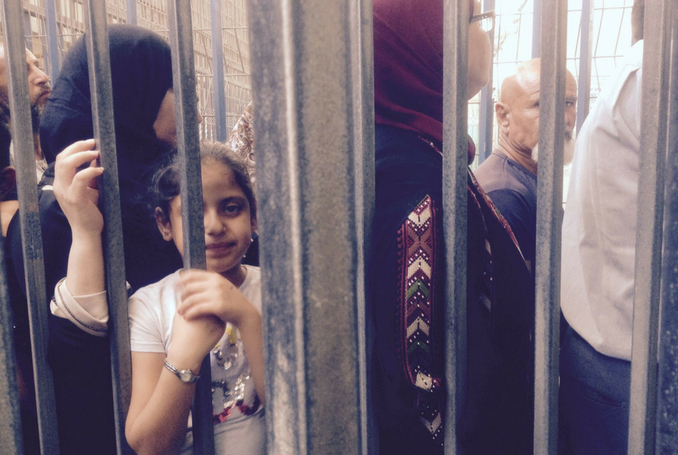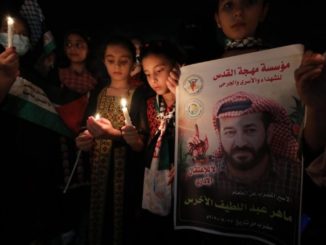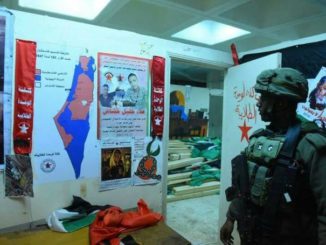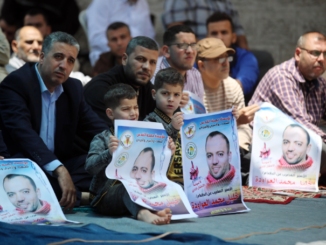
By Patrick Edgar
And what rough beast, its hour come round at last,
Slouches towards Bethlehem to be born?
— (The Second Coming by William Butler Yeats)
It has been two weeks now since I got back from my first visit to Palestine. I would now like to put some order to the impressions, the conversations, the reflections that I have had over the course of my 10-day stay. While I am well aware that I cannot speak for the Palestinians nor come even close to understanding their plight, I would, however, like to offer some insights into the situation on the ground. I shall endeavor to do this by selecting themes which I feel are salient, using a variety of sources to add meaning to the discussions I held with residents from the West Bank, whose names will for safety reasons be anonymized.
While I am aware that the picture I paint will inevitably distort the reality ‘out there’, this is the best I can do given my limitations. I hope that this modest contribution will encourage others to learn more about one of the defining issues of our time, and about their relationship to that issue. For, as Ahed Tamimi eloquently put it, the “Palestinian cause is not just for Palestinians, not even just for Arabs, the Palestinian cause is a humanitarian cause.”
Hebron: An Instance of Occupation
The city of Hebron, or Al-Khalil as it is called in Arabic (meaning ‘Companion’), provides a starting place from which to view the occupation. As a result of Hebron’s biblical import to Judaism, the city is divided into two sections: H1, controlled by the Palestinian Authority; and H2, controlled by Israel. Even the famed Cave of the Patriarchs, as Jews know it, or the Ibrahimi Mosque, as Moslems know it, has been divided.
Were it not for its religious significance, the city itself may have escaped Israel’s attention, as did Ramallah (“Ramallah was fortunate … in escaping any mention in the Bible,” recalls author Raja Shehadeh (2008: 47)). Hebron is after all firmly in the West Bank, and firmly Palestinian – the latest census shows a population of 215 000 Palestinians and between 500 to 850 Jewish settlers. Apart from conspicuous cases of violence, the city now enjoys ‘relative’ calm. But this calm hides what Breaking the Silence calls “the harsh reality of military rule,” and what B’Tselem calls “one of the most extreme manifestations of human rights violations,” as reflected in the daily travails of Hebron’s Palestinian residents – in particular, those living in H2.
One of these, Ibrahim, who lives in what had been H1 but which – through intimidation and scare tactics – he claims to now be H2 related to me the frequency with which soldiers roam the streets, use tear-gas and arrest Palestinians. He believes that the aim of these regular incursions is to ‘encourage’ people to leave the area. This reminded me of the ‘another acre another goat’ philosophy that some earlier Zionists favored so that the state of Israel would come into being from the ‘facts on the ground’.
The Oslo II map clearly shows how successful this philosophy has been, as what had been designated ‘Area A’ gives the Palestinian Authority only 3% of the West Bank. If Ibrahim’s existence is precarious straddling the border between H1 and H2, no Palestinian is safe from Israeli power. Article XII of the 1995 Israeli-Palestinian Interim Agreement holds that “Israel shall continue to carry the responsibility for defense against external threats … and will have all the powers to take the steps necessary to meet this responsibility.” The conceptual equivalence between ‘both sides’ obscures overwhelming Israeli power, just like the ‘Peace Process’ obscured the incremental nature of Israeli colonization in the West Bank.
Another resident, Ahmed, spoke to me about an arguably more mundane consequence of the occupation: the inability to use vehicular traffic from his home in the hills near the Jewish cemetery to the market below. Instead, a journey which would normally take 5 minutes now takes much longer. Palestinians who live near or within H2 are permitted to go on foot but are barred from using vehicles. There are still Palestinians who live in adjacent houses – I recall one family whose house stands not 100 meters below a military outpost whose mission is to protect worshipers at the tomb of Ruth and Jesse.
I walked down the path and came across Palestinian children playing on a mattress by a gigantic Palestinian flag – itself a response to the gigantic Star of David flag that sits atop the nearby hill which settlers have illegally appropriated. The famed Shuhada (‘Martyrs’) Street, which was once a bustling market street, has seen the closure of shops by military order and the subsequent disappearance of Palestinian life. Indeed, as it is the hub from which checkpoints fan out across H1 Palestinians are barred from even walking on it. Breaking the Silence claims that all these measures have as their aim to allow settlers the freedom to “‘enjoy’ (their emphasis) near complete segregation from their Palestinian neighbors.”
Never the Twain shall Meet
The ‘Principle of Separation’ not only prevents Palestinians from being denied free movement in Israeli-controlled areas but also, just as telling, denies Israelis access to Palestinian areas. For instance, before entering Palestinian Authority-controlled towns, a road sign instructs Israeli citizens that it is ‘forbidden’ to enter, is ‘against Israeli Law’, and that entering is ‘dangerous to Your Lives’.
The logic behind this may be grotesque but it is impeccable, for how can Israelis understand and God forbid sympathize with (for only through understanding can sympathy arise) the actions carried out by their military if they are barred from witnessing the occupation first-hand? Coexistence between Arabs and Jews had been a fact of life for hundreds of years, and it took a state-sanctioned effort to break the shared civic bonds as late as 1948.
This brings a new meaning to the word ‘Apartheid’, which some have used to describe the situation. It is worse than this. In South Africa, white South Africa relied on the labor of black South Africans; Israel actively seeks ‘separateness’ (the conquest of labor as well as that of land), notwithstanding the existence of Arab Israeli citizens within Israel but who live under a different set of citizenship laws than Israeli Jews.
If you are an Israeli settler – or an Arab permitted to walk certain designated streets – you will come face to face with a number of signs commemorating the 1929 outbreak of violence which resulted in the deaths of 67 Jews. There are street signs, murals, and shop signs, all commemorating this piece of history in Hebrew and English, though not in Arabic. There is a Jewish cemetery which is the resting place of those killed, and where stray dogs pack and shelter.
The history is not contested – riots in 1929 did result in the gruesome deaths of Jews. The signs propagate a certain narrative, however, the narrative of two irreconcilable communities, and one bent on ‘terror’. The context for such acts, never a justification but an important corrective, needs revisiting: (1) that the violence took place as part of a shift of increasing urban violence encompassed by “the trajectory of the Zionist settlement project” (Beinin, 2013: 15); (2) that local Arabs did shelter 435 Jews, sometimes at their own cost; (3) and that the violence was overwhelmingly perpetuated not against those Sephardic Jews who had lived side by side with Arabs since the mid-fifteenth century but against Ashkenazi Jews, who were “increasingly influenced by Zionism” (Winder, 2012: 9) and the implications this expansionist ideology meant for the indigenous inhabitants.
The point being made, is that history is used to propagate a simple narrative that supports the restrictions made, the barriers erected, and the lands confiscated by the Israeli state. History is nicely packaged and comes with a ribbon on top, its inconvenient details removed. The 1929 massacre is the genesis story, one which vindicates all subsequent abuses “the Zionist movement inferred behind Palestinian resistance to Jewish settlement a generic (and genetic) anti-Semitism,” writes Norman Finkelstein, “in order to conceal from the outside world and itself the rationale and legitimate grievances of the indigenous population.” Finkelstein, 2003: xiii. In this instance, two wrongs do make a right.
These abuses range from regularly denying Palestinians entry to the Ibrahimi mosque out of ‘security’ considerations (the checkpoints ironically were put up following the massacre of 29 Palestinians in the mosque by Baruch Goldstein) to intimidating and even executing Palestinians (witness what happened to 18-year old university student Hadeek al-Hashlamon in 2015 or 21-year old Abdel Fattah al-Sharif in 2016, whose executioner, Elor Azaria, now walks free). Removing the details that do not sit comfortably with ones ideology is, in a mock misrepresentation of Nikki Halley’s own words, an ‘affront to history’. As George Orwell wrote in 1984, “who controls the past controls the future: who controls the present controls the past.”
The hand Protects the Finger
Once it is established that a ‘principle of separation’ exists, it remains to be discussed how Palestinians respond to this. One of these responses, of course, has been resistance. Ahmed provided a powerful image for this: when one of their brethren is threatened by Israeli military incursions, “the hand protects the finger.” This reminded me of a scene in David Lynch’s ‘The Straight Story’, in which the main character, Alvin, on his epic journey to see his brother comes across a runaway – to demonstrate how we are stronger united than alone Alvin asks the runaway to try and break a bundle of sticks as compared with a single stick.
I would venture to suggest that the reason why Palestinians have not been browbeaten despite the discrimination, the land theft, the intimidation, the arrests, the torture, the assassinations, has been this culture of succouring those in need (“nobody goes hungry in Palestine,” stressed a British tourist whom I met in Ramallah). Razan al-Najjar, the 21-year old medic who was killed while volunteering in the recent Great March of Return, is the perfect embodiment of this. Of course, this is not to deny that a running theme through my discussions with people was the corruption of the Palestinian Authority, whom Ahmed referred to as a “security firm” for the Israelis. While Arafat came under heavy criticism over his role in signing the Oslo Accords, he is still respected for his handling of the economy – in contradistinction to the current authorities, who are seen as inept and corrupt. My own answer to this: has not the use of Quislings not been a tried and tested policy by colonizers throughout history?
“They are hopeful, and there is some madness there too,” said the kind woman who runs the charming Bethlehem Museum. This seemingly bottomless fount of hope is yet another running theme and one which was oft-repeated throughout my travels. The attendant sentiment was that of resolution – the ‘conflict’, a word which Ramzy Baroud rightly challenges for its implicit equivalence between its protagonists, has to resolve itself one way or another.
Perhaps it was my own noxious cynicism getting the better of me, but this struck me as naive. If Zionism was one thing, it was systematic and consistent – it brokered no compromise. “When they speak of Palestine …,” wrote Hugo Bergmann of Brit-Shalom in reference to mainstream Zionism, “they mean ‘our country’, that is to say, ‘not their country’” (in Finkelstein, 2003: 12). This lopsidedness was already reflected in the British Mandate’s founding document, the 1917 Balfour Declaration, which only referred to ‘existing non-Jewish communities’. The sentiment, however, comes from some prescience of mind which I am not privy to. It could come from the unshakable bonds that inform ‘non-Jewish communities’, who are deeply nourished by their faith and see their plight as a trial to overcome. It could even come from a historical understanding of the ebb and flow of empires: the region, after all, hosted, among others, the Canaanites, the Philistines, the Israelites, the Persians, the Romans, the Byzantines, the Umayyads, the Abbasids, the Crusaders, the Mamluks, the Mongols, the Ottomans, the British. Alexander the Great, Hulagu Khan and Napoleon all came and went. The Zionists, who have only just celebrated 70 years of official existence (‘my grandfather is older than the state of Israel’, proclaims one message on the separation wall), are just the latest in a long line of visitors.
On a mundane level, while the occupation is the bogeyman that forms the backdrop to any discussion about Palestine, life continues. I was reminded of this when I was invited to a friend’s family home outside Hebron: the conversation was light-hearted and revolved around books, love, hopes, food, cats, family, and well-wishes. Palestinians, I sensed, do not want to be seen merely as a ‘political issue’ (of course some do, and can even take advantage of ‘political tourism’). Despite the travails endured – perhaps ‘because’ of these – Palestinian culture is alive and well. To me, it distinguishes itself by its code of honor, its munificence (the service driver whom I had met upon my arrival in Bethlehem shared his coffee with me), its wisdom, its optimism, its resistance, its imagination.
This is perhaps what constitutes the greatest threat to the Zionist project, and could explain the attempt to deny the existence of this people (was it not Golda Meir who famously said “there is no Palestinian people”?). “Israeli identity depends on denying Palestinian identity,” states Ronnie Barkan, an Israeli Human Rights activist. The denial has a long history, and is used to justify the rights to the land as endorsed by the Balfour Declaration, the UN Partition Plan, even UN Resolution 242 in its limited call for ‘achieving a just resolution of the refugee problem’). “Palestinians have negative rights,” claims Noam Chomsky, as they “don’t perform any services to the powerful.” Nevertheless, it is a rebounding and resilient culture that mocks the occupation where it can demonstrate organizational genius (as reflected in the First Intifada of 1987-1993) and comes together in the bleakest of times. But it is beneath the clamor – in the sophisticated worldview that gives meaning to the blows of fate and transcends these – where Palestine will triumph.
‘At Least the Air We Breathe is Free’
Before catching my flight home, I decided to visit Ramallah, the de facto capital of the Palestinian Authority where Arafat had been holed up during the Second Intifada. “Once a quiet garden suburb of Jerusalem”, As Edward Said recalled, Ramallah is now a bustling city and “the center of Palestinian urban life.” While I had planned to visit both the Yasser Arafat Museum and the Mahmoud Darwish Museum I was only able to stay the night and so did not get more than a mere glimpse of the place. Before leaving, however, I strolled the streets and wandered into a dried fruits shop. The shopkeeper – testimony to Palestinian generosity – offered me ma’amoul (date-filled biscuit), a local delicacy. They were busy closing down for the night, but the man was happy to engage in conversation with me. Not only was his command of English proficient, he spoke eloquently too. This modest shopkeeper was yet another example of a rich intellectual culture that I felt grateful to have encountered.
He did not see a resolution to the conflict. Both sides, he said, “are here to stay.” He asked me whether I had been to Jericho, one of the oldest continuously inhabited places on earth. I told him I had not, but that I hoped I would one day. He said that the situation in the Jordan Valley was particularly precarious, with ongoing settlement building, cut off nature reserves, and limited access to water.
Indeed, while Israel recognizes Palestinian rights to water, these do not include the right to ownership of water as a result of what it considers ‘historic usage’: “having stolen Palestinian water for nearly three decades,” says Finkelstein, “Israelis now proclaim it is theirs” (2003: 174). “At least the air we breathe is free,” my interlocutor concluded. He went on to talk about sham elections, corrupt candidates, and the mendacity of the media. While he had little to say that was positive about the Palestinian Authority, he intimated that the source of the situation was the occupation itself (“the others are still masters of the place,” wrote Mourid Barghouti). And finally, he spoke briefly about the situation in Gaza and was heartbroken he could not help his brethren. “I cannot even send money to a bank account,” he said.
But the occupation until then, with the notable exceptions of checkpoints, soldiers, the separation wall and military outposts, had only been hearsay – I had heard about it from other people. I had spent time in Hebron during what could be considered a ‘dormant’ state. I hate to admit this, but part of me still hung to the view that it was not invasive, that all that I had read about it as part of my historical training was somehow exaggerated. It is not that I did not believe what people had consistently told me, but doubt still lingered – arising from an admixture of experience (Palestinians living full and ‘normal’ lives) with beliefs (a ‘need’ to believe that people could rationally sort out differences).
I now know that this worldview is a product of my own privileged background, like the Buddha in his princely palace before he committed to the wandering life to understand what suffering was. Perhaps Ahed Tamimi was right when she said: “those who do not live our suffering cannot understand it”. It was only when, on my second-to-last day, I traveled from Ramallah back to Tel Aviv that the occupation somehow became more real, more palpable, more menacing.
A Life of Its Own
It was a Friday and so Ramallah had closed down to honor the holy day. Fortuitously, I had engaged in conversation with my roommate at the hostel who advised that I make my way back to Tel Aviv that day since the Shabbat in Israel meant that no public transportation would be found on Saturday (and would start on Friday afternoon). As he was headed in the same direction, I asked him if I could accompany him. He magnanimously agreed with the words “we’ll do this together”.
We walked to the bus depot and boarded a bus to Jerusalem. Not long after we stopped at the Qalandia checkpoint, the main checkpoint separating Jerusalem from the northern West Bank (Qalandia village is now confined to an enclave under Israeli control; it is also home to a refugee camp for refugees driven away from Lydda, Ramle, and Jerusalem in 1948). As it was Friday, my friend and I had unwittingly become part of the great flood of pilgrims making their way to Jerusalem, some no doubt making their way to the famous Al-Aqsa Mosque (B’Tselem concludes that most people who cross “are residents of East Jerusalem who use the checkpoint to reach other parts of the city for work, school, or basic medical treatment”). We ventured into the first hall of the checkpoint, and ever so slowly made our way through the separate metal cages where people are filtered through before they meet the ubiquitous turnstiles.
I wanted to capture this but was afraid that I would not be permitted to take pictures. Being the foolhardy Irishman that I am, I took out a camera and turned to the next cage. I started clicking and was asked with some indignation by the woman in front whether “I was taking photos of ‘them'”, as though it was wrong of me to capture this moment of indignity. I said (not untrue) that I was taking a picture of the girl, whom I thought was beautiful. The woman concurred and no commotion ensued.
Once we walked past the turnstiles (which only permitted a few people at any one time), we walked into an enclosed space that led to yet more turnstiles. More waiting. I noticed there were no chairs for the elderly, who too were held up. Some Jordanian-passport holders had been turned away and we’re making their way back with resignation. An argument in the next cubicle broke out. The atmosphere was tense, people not knowing whether or not they would be granted entry. Eventually, we were allowed through, but not before going through a security check. As soon as we boarded the next bus, we made our way – with some relief – to Jerusalem. While the bus we boarded accepted the same ticket that we had bought in Ramallah, we had entered a different world.
We agreed that the experience had been ‘important’, as it had given us a glimpse of what others experienced on a daily basis. The whole process, from beginning to end, was impersonal – there was little by way of military personnel, at least ‘visible’ personnel.
Perhaps this was another example of that ‘separation principle’ that Hebron has become famous for – the less contact with ‘the other’ the better; if technology and metal railings can take their place, so much the better. Qalandia has been referred to as a ‘bureaucratic maze’ because it appears to be managed by four different institutions: police; military police; IDF Civil Administration; private security guards.
The occupation, then, when it is not at its most egregious (military clamp-down; curfews; etc.), is an arbitrary and faceless system, Kafkaesque in nature, which both creates a sense of anxiety while giving off the impression of permanence and immutability. Qalandia, it occurred to me, was an apt symbol of a process that has spread its tentacles across the West Bank.
Edward Said noted that “whatever comes up about politics arises from the lived circumstances of Palestinian life, which, most often, is surrounded by restrictions having to do with travel and residence.” Free movement of people and goods, which in Europe has become the norm, and which our passports entitle us to, is an alien concept to the vast majority of Palestinians.
My journey came to an end at Tel Aviv airport, with a full body search after some questioning from security. After going through the gate and once on the bus that would take us to our plane, I saw on the airport grounds one last manifestation of the troubles: a street sign with the words ‘Peace Road’. It was important, it seemed, that tourists be sent home with the notion that this was what the Israeli state really wanted – and it was only those ‘ungrateful Arabs’ that stymied the progress of this fine sentiment.
Given that the airport itself had been built on the ruins of Lydda, whose citizens in July 1948 were subjected to Israeli aerial and ground bombardment and the subsequent “largest single act of Jewish ethnic cleansing of the Nakba” in what became known as the ‘Lydda Death March’, the sign itself would not be out of place in a dictionary of Newspeak. My first trip to Palestine had ended, but not so the impressions, the experiences, and the insights gained.
– Patrick Edgar teaches History in an international school in Cracow, Poland. His expertise lies in modern Middle Eastern history. He is interested in working with other teachers and can be reached at patrick.edgar@gmail.com. He contributed this article to PalestineChronicle.com.







